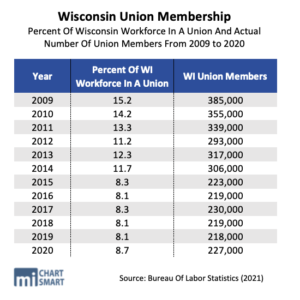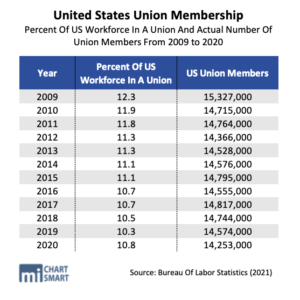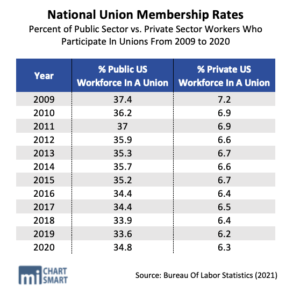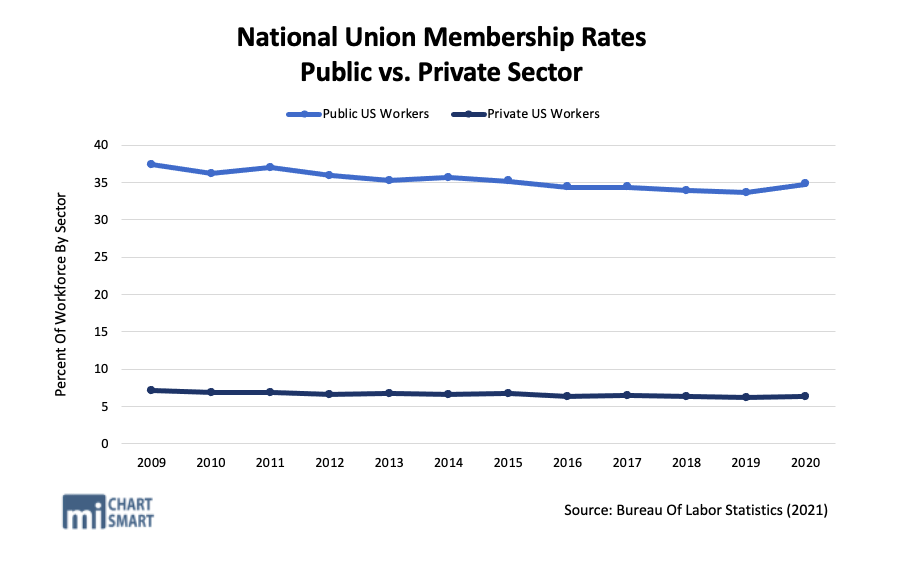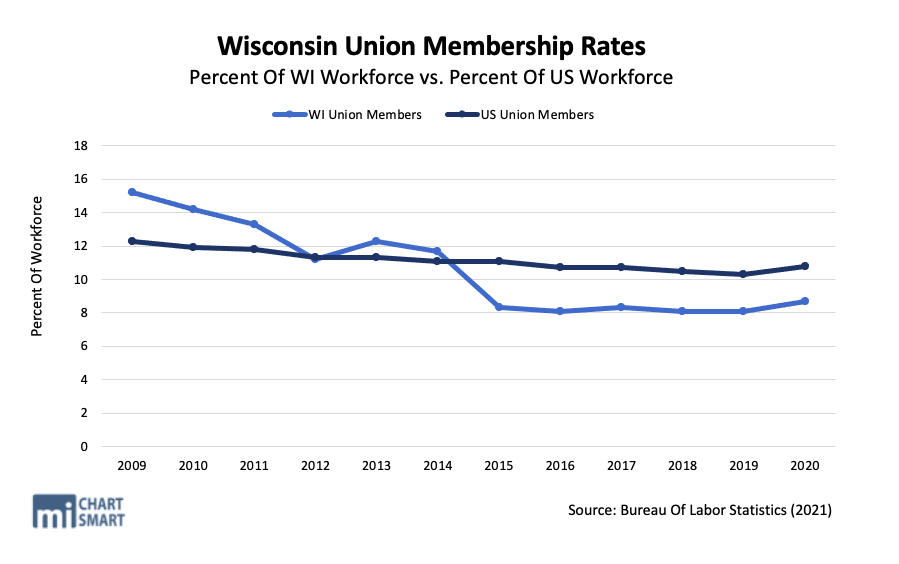
Latest BLS data shows Wisconsin, US union membership rates increased during pandemic year 2020
Wisconsin union members in 2020 made up more than 8.3% of the workforce for the first time since 2014
Despite losing 100,000 jobs during pandemic year 2020, Wisconsin union membership increased by 4.13% with 9,000 more union workers
A union member today is five times more likely to be a government employee than a private sector employee
February 15, 2021
By Lexi Dittrich
The Bureau of Labor Statistics (BLS) recently published its annual report on union membership in 2020. The data shows union membership rates increased slightly in 2020, but on the whole, union membership continues to decline in Wisconsin and in the United States.
In 2020, Wisconsin had a workforce of 2.6 million, a loss of over 100,000 workers since 2019. Of those 2.6 million workers, 227,000, or 8.7 percent, of them were union members, an increase of 9,000 members. That’s an increase of 4.13 percent over 2019, when 218,000 Wisconsin workers were part of a union.
Since 2009, a net 158,000 workers have chosen to leave their Wisconsin labor unions.
 In 2009, union membership in Wisconsin made up over 15 percent of the workforce, equal to 385,000 members. By 2015, 8.3 percent were part of a union. In 2020, for the first time since 2014, union members made up more than 8.3 percent of the Wisconsin workforce.
In 2009, union membership in Wisconsin made up over 15 percent of the workforce, equal to 385,000 members. By 2015, 8.3 percent were part of a union. In 2020, for the first time since 2014, union members made up more than 8.3 percent of the Wisconsin workforce.
The dramatic decrease in Wisconsin’s union membership rate over time is often attributed to collective bargaining reform, passed through 2011 Act 10 for public employees and 2015’s Right to Work law.
In the past decade, unions nationwide lost 7 percent of their membership, decreasing from 15.3 million union members 2009 to 14.3 million in 2020. Wisconsin has lost 41 percent of its union memberships over the same time period.
The United States workforce was made up of 132,174,000 workers in all sectors in 2020. Of the 132 million workers, 14.3 million, or 10.8 percent, were union members in 2020. This is the highest percentage of union members in the national workforce since 2015. In 2019, there were 14.5 million union members in the US, but they represented 10.3 percent of the workforce.
Wisconsin unions have 158,000 less members today than they did in 2009, a 41% drop.
Nationwide, unions have shrunk by 1,074,000 members since 2009.
Both private and public union members made up a slightly larger proportion of the United States workforce in 2020, but actual membership in both sectors dropped in the same year.
In 2020, 20.6 million people worked for the public sector. Of them, 7.2 million public sector workers, or 34.8 percent, were in a union. That’s the highest percent of the public workforce in a union since 2015. In 2019, 21 million people worked in the public sector. Of those 21 million workers, 7.1 million were union members, or 33.6 percent.
Of the 111.5 million US workers in the private sector in 2020, 7.1 million workers, or 6.4 percent, belonged to a union. In 2019, the number of private workers belonging to a union was 7.5 million, or 6.2 percent of the private workforce.
Altogether, unions across the United States have seen a net decrease of 1,074,000 members since 2009.
As BLS reported in their 2020 Union Members Summary, the “The highest unionization rates were among workers in protective service occupations (36.6 percent) and in education, training, and library occupations (35.9 percent).”
Public sector workers were over five times more likely to be in a union in 2020 than workers from the private sector. The US private sector employs over five times the number of workers that the public sector does, yet the number of union members for both sectors in 2019 was comparable, with only about a 1 million member difference between the two.
